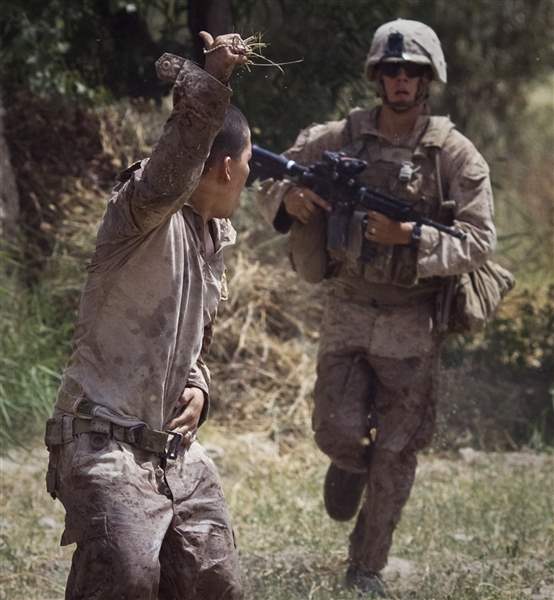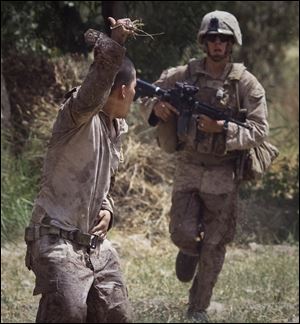
Obama likely to withdraw 10,000 US troops from Afghanistan this year in phased drawdown
6/21/2011
Lance Cpl. Blas Trevino of the 1st Battalion, 5th Marines, left, holds onto the gunshot wound in his belly and gestures toward his troops as he runs to a medevac helicopter from the U.S. Army's Task Force Lift "Dust Off", Charlie Company 1-214 Aviation Regiment on June 11, 2011, after he got shot in the stomach outside Sangin, in the Helmand Province of southern Afghanistan. The Army's 'Dust Off' crew needed two attempts to get him out, as they were fired upon and took five rounds of bullets into the tail of their aircraft.
ASSOCIATED PRES

Lance Cpl. Blas Trevino of the 1st Battalion, 5th Marines, left, holds onto the gunshot wound in his belly and gestures toward his troops as he runs to a medevac helicopter from the U.S. Army's Task Force Lift "Dust Off", Charlie Company 1-214 Aviation Regiment on June 11, 2011, after he got shot in the stomach outside Sangin, in the Helmand Province of southern Afghanistan. The Army's 'Dust Off' crew needed two attempts to get him out, as they were fired upon and took five rounds of bullets into the tail of their aircraft.
WASHINGTON — President Barack Obama is set to announce a blueprint for bringing U.S. troops home from Afghanistan that is expected to reduce the number of troops by up to 5,000 next month, as well as a broader plan for recalling the rest of the 30,000 surge forces he sent there in 2009.
The plan Obama will announce in a speech Wednesday is designed to put the U.S. on a path toward giving Afghans control of their own security by 2014.
CNN reported Tuesday morning that the surge troops all would be withdrawn by the end of 2012.
Obama was given a range of options for the withdrawal last week by Gen. David Petraeus, the top U.S. and NATO commander in Afghanistan. The military favors a gradual reduction in troops but other advisers are advocating a significant decrease in the coming months.
The president has said he favors a significant withdrawal, his advisers have not quantified that statement.
At a democratic fundraiser in Washington Monday night, Obama said that by the end of the year, "we will be transitioning in Afghanistan to turn over more and more security to the Afghan people."
Following the announcement on the drawdown, Obama will visit troops Thursday at Fort Drum, the upstate New York military base that is home to the 10th Mountain Division, one of the most frequently deployed divisions to Afghanistan and Iraq.
While much of the attention is focused on how many troops will leave Afghanistan next month, the more telling aspects of Obama's decision center on what happens after July, particularly how long the president plans to keep the surge forces in the country.
Obama is expected to at least map out the initial withdrawal of the surge troops when he addresses the public. But whether those forces should come out over the next eight to 12 months or slowly trickle out over a longer time is hotly debated.
Military commanders want to keep as many of those forces in Afghanistan for as long as possible, arguing that too fast a withdrawal could undermine the fragile security gains in the fight against the Taliban insurgency in Afghanistan, the al-Qaida training ground for the Sept. 11 attacks. There are also concerns about pulling out a substantial number of U.S. forces as the heightened summer fighting season gets under way.
Retiring Defense Secretary Robert Gates has said he believes the initial drawdown should be "modest."
But other advisers are backing a more significant withdrawal that starts in July and proceeds steadily through the following months. That camp believes the slow yet steady security gains in Afghanistan, combined with the death of Osama bin Laden and U.S. success in dismantling much of the al-Qaida network in the country, give the president an opportunity to make larger reductions this year.
There is also growing political pressure on Capitol Hill for a more significant withdrawal. Twenty-seven senators, Democrats as well as Republicans, sent Obama a letter last week pressing for a shift in Afghanistan strategy and major troop cuts.
"Given our successes, it is the right moment to initiate a sizable and sustained reduction in forces, with the goal of steadily redeploying all regular combat troops," the senators wrote. "The costs of prolonging the war far outweigh the benefits."
Arizona Sen. John McCain, the top Republican on the Senate Armed Services Committee, differed with that assessment. He told ABC's "Good Morning America" on Tuesday that he agreed with Gates in hoping the withdrawal would be "modest."
"I believe that one more fighting season and we can get this thing pretty well wrapped up," McCain said.
There is broad public support for starting to withdraw U.S. troops. According to an Associated Press-GfK poll last month, 80 percent of Americans say they approve of Obama's decision to begin withdrawal of combat troops in July and end U.S. combat operations in Afghanistan by 2014. Just 15 percent disapprove.
Obama has tripled the number of U.S. forces in Afghanistan since taking office, bringing the total there to about 100,000. The 30,000-troop surge he announced at the end of 2009 came with the condition that he would start bringing forces home in July 2011.
The president took months to settle on the surge strategy. This time around, aides say the process is far less formal and Obama is far more knowledgeable about the situation in Afghanistan than he was in 2009, his first year in office.
Aides say Obama won't be overhauling the U.S. strategy in Afghanistan as he starts the drawdown. Instead, they say he sees it as a critical part of the process to end the U.S. combat mission in Afghanistan by the end of 2014 and turn security responsibility over to the Afghans.
On a trip to Afghanistan earlier this month, Gates advocated for a comprehensive decision from the president.
"I think to make a decision on July in complete isolation from anything else has no strategic meaning," Gates said. "And so part of that has to be kind of, what's the book end? Where are we headed? What's the ramp look like?"
Gates is retiring from the Pentagon June 30.
There are also indications that the administration, having learned from the U.S. experience in Iraq, will set deadline dates for the drawdown as it progresses, in order to keep pressure on the Afghans and give Congress mileposts.
With Iraq as a blueprint, commanders will need time to figure out what they call "battlefield geometry" — what types of troops are needed where. Those could include trainers, intelligence officers, special operations forces, various support units — from medical and construction to air transport — as well as combat troops.
Much of that will depend on where the Afghan security forces are able to take the lead, as well as the state of the insurgency. Part of the debate will also require commanders to determine the appropriate ratio of trainers versus combat troops.